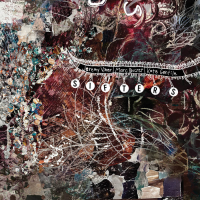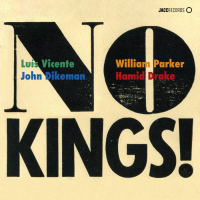Home » Jazz Articles » Album Review » Craig Taborn: Daylight Ghosts
Craig Taborn: Daylight Ghosts
Several years ago Taborn's move to ECM was inaugurated by Avenging Angels, a solo piano work, that opened a new chapter in this pianist's career and opus which was followed by Chants, a trio date and several in and off-label collaborations. These releases showcased the expansiveness of his musical thoughts and vision as he straddled a broad swath of the aesthetic continuum of jazz and improvised music.
With Daylight Ghosts, Taborn stretches his collaborative muscles with a unique quartet that is dedicated to innovative ideas within the jazz, chamber music, and improvised spectrum. This record offers compositions all but one written by Taborn but all of them are amplified and transformed via the group's inventive exploratory leanings. All of the tracks, starting from the opening "The Shining One" to the closing "Phantom Ratio" have a quality of being a journey, with the players veering toward microscopic themes but rarely coming right out and stating something with clarity. This almost formless state in a flux requires capable musicians that can immerse themselves in the music and their respective instruments, and in turn to feed off each other in order to land on a singular wavelength. Regardless how the compositions commence or resolve, each musician here happens to be a keenly responsive player unafraid of leaping into the unknown. Because of that, it is easy to miss how much territory they cover, especially in the beginning.
Amongst Taborn's greatest strengths is his ability to navigate the quartet in ways that make its instruments mesh seamlessly where they sound less like a collection of instruments and more like a singular voice. The interplay that he shares with the others is not just intuitive but it is seamlessly empathic. In their capable hands, this music is more like a boundless medium through which the process of improvisation is allowed to breathe and to come to the fore. The group possesses an almost intimate ability to unfurl Taborn's compositions with a rare patience especially on tracks such as the title track, "Silence" and "Ancient" which makes these tracks investigations into broad—spectrum potentials of color, texture, dynamics, and melody. The production of Manfred Eicher relies on space, silence and inner drama, and he provides the right guidance but Taborn is composing from an entirely different place than most. "The Great Drama" is an introspective exploration with attention to sonority, space, quiet passages, and subtle dynamism.
These compositions serve both as launching pads for collective improvisation and as signposts along the way. A testament to their like-mindedness, the quartet harbors an impeccable degree of cohesion, especially in terms of variation of dynamics. Each player prods at his instrument to expose uncharted timbres, as exemplified on the closing "Phantom Ratio." The contrast between the heavy acoustic and electric sounds and the tune's calmer passages is simply thrilling.
The contrasting introspective explorations on Daylight Ghosts with its shades of light and darkness, surfaces and edges, brooks, and pebbles, and where avant-informed palletes emerge and are juxtaposed and combined, show another angle of Taborn's rare musical intuition, compositional and playing gifts. It is also an example of what can come out of a meeting of kindred spirits. This is music on a higher intellectual plane but it's very human.
Track Listing
The Shining One; Abandoned Reminder; Daylight Ghosts; New Glory; The Great Silence; Ancient; Jamaican Farewell; Subtle Living Equations; Phantom Ratio.
Personnel
Craig Taborn
pianoCraig Taborn: piano, electronics; Chris Speed: tenor saxophone, clarinet; Chris Lightcap: acoustic bass, electric bass; Dave King: drums, electronic percussion.
Album information
Title: Daylight Ghosts | Year Released: 2017 | Record Label: ECM Records
Tags
PREVIOUS / NEXT
Craig Taborn Concerts
Support All About Jazz
 All About Jazz has been a pillar of jazz since 1995, championing it as an art form and, more importantly, supporting the musicians who make it. Our enduring commitment has made "AAJ" one of the most culturally important websites of its kind, read by hundreds of thousands of fans, musicians and industry figures every month.
All About Jazz has been a pillar of jazz since 1995, championing it as an art form and, more importantly, supporting the musicians who make it. Our enduring commitment has made "AAJ" one of the most culturally important websites of its kind, read by hundreds of thousands of fans, musicians and industry figures every month.




















